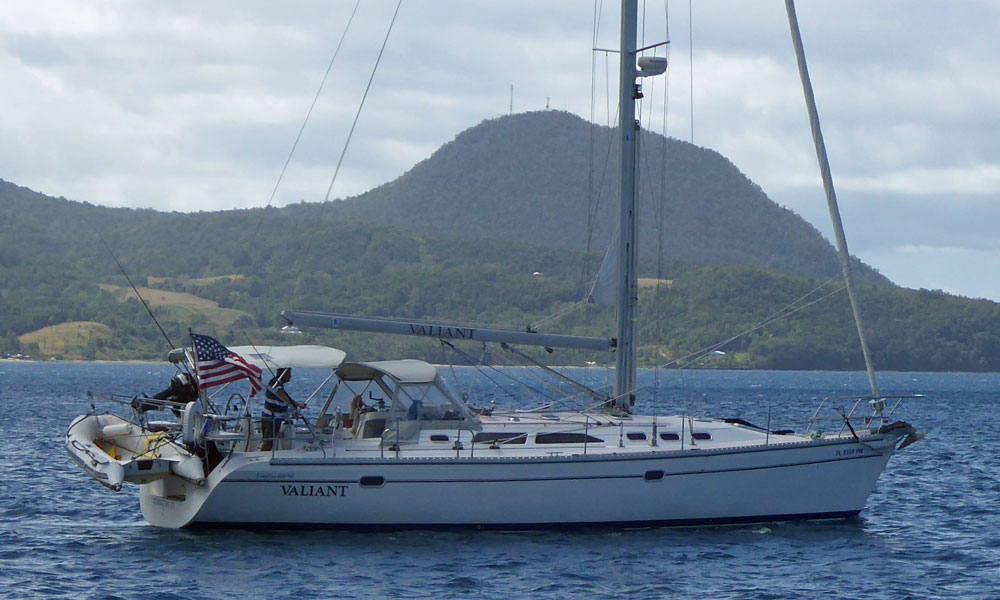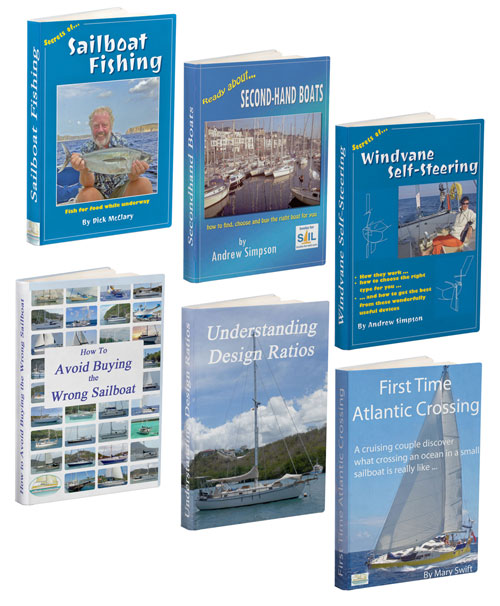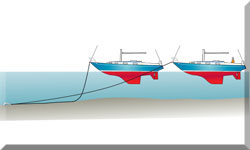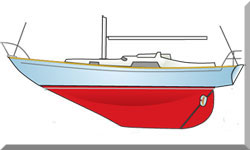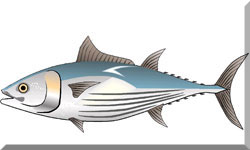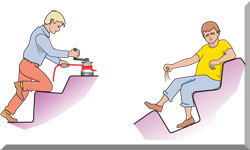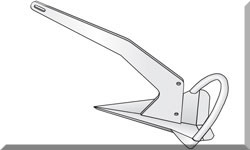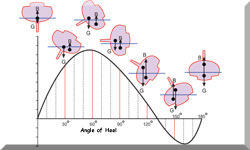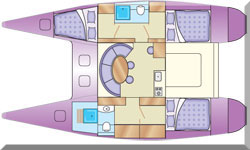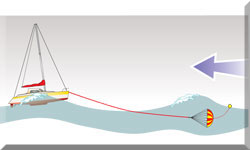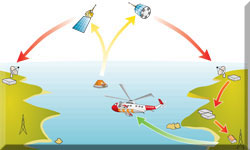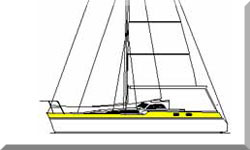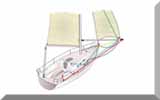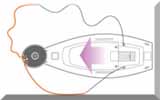- Home
- Cruising Yachts 40' to 45'
- Catalina 400
The Catalina 400 Sailboat
Specs & Key Performance Indicators
The Catalina 400 MkII is a spacious and well-appointed masthead sloop designed by Frank and Gerry Douglas and built by Catalina Yachts in the United States.
Introduced in 2000, it is an evolution of the original Catalina 400, featuring notable upgrades like twin helm stations and a walk-through transom, enhancing both cockpit functionality and stern access. Constructed with a fibreglass hull, it was offered with both a deep fin keel or a shallower wing keel option. Its design ratios suggest a moderate-to-light displacement cruiser that offers good performance in a variety of conditions, making it an excellent platform for coastal cruising and comfortable liveaboard life. Production of the Catalina 400 series concluded around 2012.
Published Specification for the Catalina 400
- Keel & Rudder Configuration: Fin keel with bulb & spade rudder (standard) or wing keel option.
- Hull Material: Fibreglass (FG).
- Length Overall*: 41′6"/12.65 m
- Waterline Length*: 36′6"/11.13 m
- Beam*: 13′6"/4.11 m
- Draft (Fin Keel)*: 6′11"/2.11 m
- Draft (Wing Keel)*: 5′4"/1.63 m
- Rig Type: Masthead Sloop with double spreaders, in-line.
- Displacement (Fin Keel)*: 19,700 lb/8,936 kg
- Displacement (Wing Keel)*: 20,500 lb/9,299 kg
- Ballast (Fin Keel)*: 7,200 lb/3,266 kg
- Ballast (Wing Keel)*: 8,000 lb/3,629 kg
- Sail Area (Main plus 100% foretriangle)*: 808 ft2/75.07 m2
- Water Tank Capacity: 107 US gals/405 L (total across two tanks plus water heater)
- Fuel Tank Capacity: 44 US gals/167 L
- Hull Speed (Theoretical): 8.1 kts
- Designer: Frank Douglas and Gerry Douglas
- Builder: Catalina Yachts (USA)
- Year First Built (400 MkII): 2000
- Year Last Built (400 Series): The 400 series was in production until around 2012.
- Number Built: The exact number of MkIIs is not definitively known, but production of the Catalina 400 series reportedly exceeded 100 hull numbers by late 1996, and some sources estimate around 500 total 400s were built before production ended.
See also Catalina Yachts: The American Dream of Sailing Attainability...
* Used to derive the design ratios referred to later in this article - here's how they're calculated...
Design Evolution & Key Options
The Catalina 400 was first built in 1994, with the improved MkII version being introduced in 2000. The key changes focused on enhancing the deck, cockpit, rig, and interior to address sailor feedback and incorporate modern trends.
- Cockpit & Deck: The most visible change was the introduction of a larger cockpit with twin helm wheels. This design offers three main advantages: improved visibility for the helmsman, easier stern access through a walk-through transom and swim platform, and a larger central dining area in the cockpit. The MkII also has a redesigned deck.
- Rigging: The MkII features a taller mast with slightly swept-back spreaders compared to the original, often resulting in a marginal performance boost and a slightly different sail plan.
- Interior Layouts: While both versions are available in two- or three-cabin layouts, the MkII generally offers a more open-plan saloon and an updated galley with more storage. The popular two-cabin version provides a very large aft master suite with a queen berth, but this does come at the expense of some cockpit locker storage space, which is a common trade-off in designs favouring large private cabins.
Sail Areas & Rig Dimensions
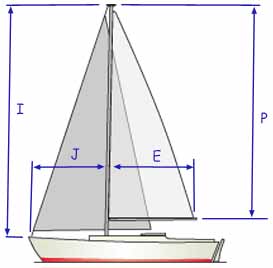 Sail Areas & Rig Dimensions
Sail Areas & Rig DimensionsThe Catalina 400 MkII is rigged as a masthead sloop, meaning the forestay is attached near the top of the mast. The rig dimensions and sail areas for the standard rig are:
Sail Areas
- Mainsail Area: 37.11 m² (400 ft²)
- 100% Foretriangle Area: 37.92 m² (408 ft²)
- Total Sail Area: 75.04 m2 (808 ft2)
Rig Dimensions
- I (foretriangle height): 16.05 metres (52'8")
- J (foretriangle base): 4.72 metres (15' 6")
- P (main luff): 14.33 metres (47' 0")
- E (main foot): 5.18 metres (17' 0")
This masthead rig is robust and straightforward for cruising, allowing for powerful headsails like a 135% genoa to be easily flown on a roller furler.
Published Design Ratios
The Key Performance Indicators (KPIs)
For the standard Fin Keel version:
1. Sail Area/Displacement Ratio: 17.8
2. Ballast/Displacement Ratio: 36.6
3. Displacement/Length Ratio: 181
4. Comfort Ratio: 25.2
5. Capsize Screening Formula: 2.0
How do the Catalina 400 MkII's design ratios predict its sailing characteristics?
1. Performance: A value between 15 and 20 indicates a reasonably well-canvassed cruiser. This boat should perform well in moderate winds and be able to approach its theoretical hull speed without being overly sensitive or demanding to sail. It's not a racing yacht, but it won't be a slouch either.
2. Stability/Stiffness: This moderate figure suggests a boat with good initial stability that will stand up to its rig well. It is typical for a production cruiser, indicating a powerful, relatively stiff boat that can carry its sail area effectively.
3. Weight: A D/L ratio between 180 and 220 is generally considered moderate displacement for a modern cruising yacht. The Catalina 400 MkII is light for a full-fledged cruiser, suggesting it is easily driven and responsive, with less hull drag.
4. Motion Comfort: This ratio relates displacement to waterline length. A value around 30 is considered comfortable for ocean passage-making. At $25.03$, the 400 MkII suggests a motion in a seaway that is quicker and perhaps slightly more active than heavier, full-keel cruisers, though still acceptable for coastal and moderate offshore work.
5. Safety: This formula is a simple check for boats intended for offshore work. Values of 2.0 or less are typically considered suitable for offshore sailing. A value of 2.00 puts the boat right at the threshold, suggesting that while capable, it is not an extremely heavy or deep-ballasted offshore design.
Based on these figures, the Catalina 400 MkII is clearly designed to be a fast, modern cruising yacht. It is easy to handle, responsive, and prioritises a blend of comfortable living and solid, dependable performance without leaning too heavily toward either a pure performance racer or a heavy-displacement passagemaker.
What are the limitations of using design ratios to define a sailboat’s sailing characteristics?
While helpful for an initial comparison, design ratios offer a purely theoretical assessment and have important limitations. As an experienced sailor, I cannot stress enough that they should not be the sole basis for a purchase decision.
- Weight & Load: Ratios are typically calculated using the boat's design or light displacement. In reality, a cruising sailor or liveaboard will load the vessel with gear, spares, provisions, fuel, and water, dramatically increasing the actual displacement. This can lower the SA/D ratio (making the boat feel sluggish) and increase the D/L ratio (slowing the boat down), significantly altering the boat's behaviour compared to the theoretical figures.
- Hull Shape & Motion: Ratios like the Comfort Ratio do not account for the hull's form. The 400's wide beam carried well aft, which is excellent for interior volume and form stability, can lead to a quicker, more 'rolly' motion in a following sea compared to a boat with finer ends, despite having a similar Comfort Ratio to some boats that handle differently.
- Centre of Gravity: The Ballast/Displacement ratio is important, but it doesn't indicate the ballast placement. A boat with the same B/D ratio but a shallower keel will have less righting moment than one with a deeper keel with the ballast concentrated at the tip (a bulb), thus affecting its ultimate stability and stiffness. The Angle of Vanishing Stability (AVS), which is not a simple ratio, is a far more reliable indicator of ultimate offshore safety.
In short, ratios are a guide, not a gospel. An on-the-water test sail and a detailed survey are the only true ways to assess a boat’s suitability.
This article was written by Dick McClary, RYA Yachtmaster and author of the RYA publications 'Offshore Sailing' and 'Fishing Afloat', member of The Yachting Journalists Association (YJA), and erstwhile member of the Ocean Cruising Club (OCC).
FAQs & Key Takeaways
Is the Catalina 400 MkII suitable for blue water cruising?
Is the Catalina 400 MkII suitable for blue water cruising?
The Catalina 400 MkII is generally considered a highly capable coastal and moderate offshore cruiser. The Capsize Screening Formula of 2.00 puts it in the 'acceptable' category for ocean work. Its generous water and fuel capacity, stout rigging, and comfortable interior make it appealing for long-term liveaboards and extended passages. However, it is not built to the standards of heavier, dedicated blue water yachts, and prospective owners planning high-latitude or extreme passages may want to consider additional strengthening or modification of high-stress areas like the standing rigging base and rudder bearings. Its performance is generally good, helping to ensure timely passages.
How does the twin-helm cockpit design function for short-handed sailing?
How does the twin-helm cockpit design function for short-handed sailing?
The twin-helm design is a major feature of the MkII. For short-handed sailing, the dual wheels allow the helmsman to choose the windward side for better visibility of the sails and the water, a significant advantage over a single-wheel, centre-line setup. All primary control lines are led aft to the cockpit, making the boat manageable for a single or double-handed crew. The trade-off is often a more complex steering system to maintain compared to a single-rudder quadrant setup.
What are the main engine details for the Catalina 400 MkII?
What are the main engine details for the Catalina 400 MkII?
The Catalina 400 MkII is typically fitted with a four-cylinder, fresh-water-cooled Yanmar diesel engine (often the 4JH4BE or similar) producing 56 HP or 41.8 kW. This is a dependable, well-regarded engine in the cruising community, offering sufficient power to handle the boat in adverse weather or strong currents.
What is the advantage of the wing keel option?
What is the advantage of the wing keel option?
The optional wing keel reduces the draft from the standard 6′11" (2.11 m) to a shallower 5′4" (1.63 m). This is a significant advantage for cruising in shallow waters, such as parts of the Bahamas, the US East Coast, or the Mediterranean, allowing access to anchorages that a deeper keel would prohibit. The trade-off is a slight reduction in stability and upwind performance compared to the deeper fin keel, which has a higher righting moment due to the ballast's lower centre of gravity.
Is the Catalina 400 MkII a good liveaboard sailboat?
Is the Catalina 400 MkII a good liveaboard sailboat?
Yes, the Catalina 400 MkII is an excellent liveaboard sailboat. Its key strengths are its generous beam, which translates to massive internal volume, comfortable headroom, and spacious cabins. The two-cabin version, in particular, offers a very large aft master suite and two heads, providing excellent privacy and comfort for a couple. The well-equipped galley and ample ventilation contribute to a comfortable lifestyle at anchor or in a marina. The main drawback for liveaboards is often the relatively limited external locker storage, a compromise for the large aft cabin.
How does the build quality & construction stand up over time?
How does the build quality & construction stand up over time?
Catalina Yachts is known for building solid, practical cruising yachts. The 400 MkII features a hand-laid fibreglass hull and a deck that is cored with balsa for stiffness and insulation, typically with solid fibreglass in high-stress areas where deck hardware is mounted. While generally robust, like any boat of this age, potential buyers should have a thorough survey, paying close attention to areas around deck fittings and the keel-hull joint for any signs of water intrusion or stress, common concerns for production yachts of this era.
Resources Used
- CATALINA 400 Mk II - SailboatData.com: https://sailboatdata.com/sailboat/catalina-400-mk-ii/
- Catalina 400 mkII - Catalina Yachts - PDF Catalogs | Documentation | Boating Brochures: https://pdf.nauticexpo.com/pdf/catalina-yachts/catalina-400-mkii/20130-1759.html
- 2000 Catalina Yachts Catalina 400 MkII - Fin Keel - TheBoatDB: https://theboatdb.com/boat/catalina-yachts-catalina-400-mkii-fin-keel-2000-280
- Catalina Owner: Boat Specifications - Catalina 400: https://catalina.sailboatowners.com/boats.php?mid=91
- History – Catalina Yachts: https://www.catalinayachts.com/history/
Recent Articles
-
Modern Boat Electronics and the Latest Marine Instruments
Dec 20, 25 05:27 PM
Should sailboat instruments be linked to the latest boat electronics as a fully integrated system, or is it best to leave them as independent units? -
Hans Christian 43: Classic Bluewater Cruiser & Liveaboard Sailboat
Dec 10, 25 04:37 AM
Explore the Hans Christian 43: a legendary heavy-displacement, long-keel sailboat. Read our in-depth review of its specs, design ratios, and suitability for offshore cruising and living aboard. -
Planning Your Sailboat Liveaboard Lifestyle: An Ocean Sailor's Guide
Dec 06, 25 05:18 AM
Seasoned sailors share their methodical risk analysis for planning a secure Sailboat Liveaboard Lifestyle, covering financial, property, and relationship risks.
